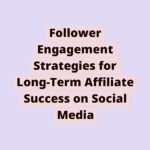Ever scrolled through your social media feed and felt mesmerized by a story? That’s the power of storytelling in affiliate marketing. Today, it’s not just about selling a product. It’s about weaving a narrative that resonates.
Platforms like Instagram, Twitter, and Facebook have become stages for these narratives. Stories of success, transformation, and discovery fill our feeds, making products part of a larger conversation.
But how can you harness this power? How do you tell a story that not only captures attention but also drives action? Stick around. Let’s dive into the art of storytelling in affiliate marketing on social media channels.
Affiliate Marketing Strategies on Instagram
So, diving into Instagram, it’s more than just selfies and food pics. It’s a goldmine for affiliate marketers. Why? Because storytelling here goes beyond words. Let’s explore how.
First off, think visually. Instagram is all about the eye candy. High-quality images and videos can make your product story pop. They’re your first step in grabbing attention.
Engage With Your Audience
But it’s not enough to just post pretty pictures. Engagement is key. Reply to comments, ask questions in your captions, and use polls in your stories. Make your followers feel part of the journey. This builds trust, and guess what? Trust sells.
Use the Right Hashtags
Hashtags are your best friend on Instagram. They extend your reach beyond your immediate followers. The trick is to use relevant and targeted hashtags. They should tell your story, too. Think of them as breadcrumbs leading to your product.
Incorporate these strategies, and Instagram can become a powerful chapter in your affiliate marketing story. It’s about making meaningful connections and letting those visuals do the talking. Ready to give it a shot? Let’s turn those scrolls into sales.
Engaging Audiences with Compelling Stories
Now, let’s talk storytelling. It’s the heart of engaging audiences. In a world where everyone’s fighting for attention, a good story can be your secret weapon.
Think about it. When was the last time you were captivated by a product description? Probably can’t remember, right? But a story that connects with your emotions or experiences? That sticks.
So, how do you craft these captivating tales? Start with your why. Why does your product exist? What problem does it solve, and whose life does it make better? That’s the core of your story.
But don’t stop there. Be authentic. Share your highs and lows. People resonate with vulnerability. It makes your brand relatable. Remember, perfection is intimidating; humanity is inviting.
And, visuals! Don’t forget, especially on platforms like Instagram, visuals tell half the story. They’re not just ornaments; they’re narrators. Use them to amplify your message, not drown it.
Finally, listen. Engagement is a two-way street. Pay attention to the stories your audience shares with you. It’s a goldmine of insights and an opportunity to show you care.
Stories are powerful. They can turn a casual browser into a loyal follower, and even better, a brand advocate. So go on, tap into the power of storytelling. Watch your engagement soar.
Utilizing Facebook for Successful Affiliate Marketing
Alright, let’s dive into the golden opportunity that is Facebook for affiliate marketing. It’s no secret that Facebook is a giant in the social media world. With billions of active users, the platform is a treasure trove for affiliate marketers. But how do you tap into this goldmine without getting lost in the crowd?
First off, know your audience. Facebook offers incredible tools for targeting. You can narrow down by interests, age, location, and much more. It’s like having a billboard in exactly the right neighborhood. Use this to your advantage to ensure your affiliate links are seen by the right eyes.
Crafting Engaging Content
Now, it’s all about the content. Remember those storytelling skills we talked about? This is where they really come into play. Create posts that are engaging and offer value. It’s not just about promoting a product; it’s about solving a problem for your audience. Mix it up with videos, images, and even live streams to keep things interesting.
Engagement is key on Facebook. The more people interact with your content, the more it gets seen. Encourage comments by asking questions. Run polls. Jump into discussions. The algorithm loves this stuff, and it helps build a community around your brand.
Paid Advertising: A Boost Worth Considering
Consider leveraging Facebook Ads. Yes, there’s a cost, but the targeting capabilities can give your affiliate marketing efforts a significant boost. Start small, test different ads, and analyze the results. Rinse and repeat until you find what works best for you.
Remember, success on Facebook doesn’t happen overnight. It’s about consistency, engaging content, and being genuinely helpful. Build those relationships and the sales will follow. Your affiliate marketing journey on Facebook could be the game-changer you’ve been looking for. Give it a shot!
Crafting Authentic Stories for Twitter Promotion
Moving on to Twitter, the landscape changes but the essence of good marketing stays the same. Twitter is all about brevity and wit. Your stories need to be concise but powerful. It’s like crafting a haiku for each promotion. Sounds challenging, right? But oh, it’s also incredibly fun once you get the hang of it.
Start with the heart of your message. What’s the core story you’re trying to tell? Twitter forces you to cut the fluff and get straight to the point. This can actually work in your favor. A clear, compelling story can be much more impactful than a lengthy post that meanders.
Now, think about your audience on Twitter. They scroll through their feeds at lightning speed. Your job? To make them stop and click. How? Use vivid imagery and strong, action-packed words. Even if you’re limited in characters, a well-chosen picture alongside your tweet can speak volumes.
Also, don’t forget hashtags. They’re not just trendy; they’re functional. They connect your stories to wider conversations and communities. But beware of overdoing it. One or two relevant hashtags per tweet is a good rule of thumb. It keeps things focused and effective.
Engagement is the name of the game on Twitter. Ask questions. Hop on trending topics where it makes sense. Reply to comments. It’s this back-and-forth that builds relationships and trust in the long run. And when people trust you, they’re more likely to take an interest in your promotions.
Lastly, embrace the fluid nature of Twitter. Trends come and go. What worked yesterday might not work tomorrow. Stay adaptable. Keep experimenting with your stories and promotions. Over time, you’ll find what resonates with your audience and turn those fleeting Twitter moments into lasting marketing success.
Driving Conversions Through Storytelling
Now that we’ve got our stories packed and ready, let’s talk getting results. Yes, conversions! It’s one thing to capture attention, but another to turn that attention into action. The magic ingredient? Emotion, stirred through storytelling.
First up, let’s tackle the ‘why’. Why should your audience care? Answering this question turns your story from just another post into a compelling narrative that resonates. It connects your offering to their desires or challenges, making it irresistible.
Remember, emotions drive decisions. If your story tugs at the heartstrings or lights up someone’s imagination, they’re more likely to take the leap from observer to customer. Think about it. We’re more likely to make a purchase if we feel understood or if a product sparks joy, right?
Here’s a tip: Use testimonials and success stories. Nothing speaks louder than real-life experiences. They add credibility and showcase the human impact of your product. And voila, your audience starts to see themselves in these stories, which nudges them closer to conversion.
Let’s not forget the call-to-action (CTA). It’s your story’s climax. Your CTA should feel like a natural next step, not a sales pitch. Make it clear and compelling. Tell your audience exactly what you want them to do next and why it’s worth their while.
A/B testing is your friend here. Not every story or CTA will hit the mark on the first try, and that’s okay. Experiment with different angles and pay attention to what works best. This isn’t just about tweaking; it’s about learning what your audience loves.
To wrap up, storytelling isn’t just about selling. It’s about building a connection that can transform a casual browser into a loyal customer. Be genuine, be consistent, and watch your stories drive not just conversions, but meaningful relationships.
Expanding Reach with Story-driven Pinterest Marketing
So, we’ve talked about the power of storytelling in conversions. But where else can we sprinkle this magic? Enter Pinterest, a visual wonderland perfect for expanding your reach with stories.
Think of Pinterest as more than a place for recipes and DIY projects. It’s a platform where visuals tell stories, and these stories can lead viewers on a journey to your products. But how do you stand out in this sea of images?
First off, let your visuals do the talking. Create pins that capture your story in a glance. Bright, eye-catching images paired with compelling captions are your best friends here. Remember, each pin is an opportunity to tell a part of your story.
Next, consistency is key. Just like any good series, your pins should weave a continuous narrative. This doesn’t mean they all look the same, but they should feel connected. A consistent style or theme helps, making your brand instantly recognizable.
Now, onto boards. Think of boards as chapters in your story. Each board can represent a different aspect of your brand or product line, allowing you to organize your narrative. This makes it easier for users to follow along and dive deeper into your story.
Engagement, folks, can’t be overlooked. Pinterest may be visual, but it’s also social. Engage with your audience through comments and repins. Show them there’s a real person behind those pins, willing to connect and share.
Lastly, don’t forget about Pinterest SEO. Yes, keywords matter here too. Use them in your pin descriptions, board titles, and even your profile to ensure your story-driven content reaches the right viewers.
In essence, Pinterest offers a unique opportunity to enrich your storytelling canvas. By strategically leveraging its visual format, you can captivate an audience that’s ready to be taken on your brand’s journey. Let your imagination run wild, and watch as your reach expands in the most visually pleasing way.
Measuring Impact: Storytelling Analytics
Now that we’re knee-deep into crafting and sharing our stories, how do we gauge their impact? This is where storytelling analytics come into the picture. It sounds a bit technical, right? But stick with me; it’s pretty straightforward and super useful.
First up, engagement metrics. These are your bread and butter. Think likes, shares, comments, and views. High engagement means your story is resonating with your audience. It’s not just about the numbers, though. Read through those comments to get a sense of the emotions and discussions your story is sparking.
But wait, there’s more to it. Conversion rates also play a huge part. This is where you see if those engaged listeners are taking the leap to become customers or subscribers. A spike in website visits, sign-ups, or sales after a story goes live? You’re on the right track. It’s like watching your story lead people by the hand towards your brand.
Don’t overlook the power of social listening. Tools and platforms can help you track mentions of your brand or specific stories across the web. It’s like having ears everywhere, hearing what people say about your brand. This feedback can be gold, offering insights into audience perceptions and even new storytelling ideas.
Here’s a little trick too: keep an eye on the bounce rate from your storytelling channels to your main platforms. A low bounce rate means your story was compelling enough to make viewers stick around. They didn’t just visit; they took the time to explore. That’s a win in my book.
And lastly, the length of engagement is key. It’s one thing to attract eyeballs, but another to keep them glued. Analytics can show you how long people stay engaged with your content. Long engagement times? Your story’s captivating. If not, it might be time to tweak your narrative.
The Bottom Line: Storytelling Power in Affiliate Marketing
So, we’ve journeyed through the maze of storytelling in affiliate marketing. What have we learned? Essentially, storytelling is not just fluff; it’s a powerhouse strategy for connecting, engaging, and converting.
Let’s not forget, stories humanize your affiliate efforts. They transform cold promotions into warm, relatable narratives. People remember stories, not product specs. This connection is invaluable.
And analytics? They’re your roadmap. They show where your stories shine and where there’s room to grow. Use them to tweak, adjust, and perfect your storytelling art. It’s an ongoing process, but oh, so worth it.
Remember, the key is authenticity. Genuine stories resonate deeply, fostering trust and loyalty. This isn’t about making a quick buck. It’s about building relationships. And in the vast sea of affiliate marketing, those relationships are your treasure.
In conclusion, wield the power of storytelling wisely. Let it amplify your affiliate marketing, making every link, every product, and every promotion part of a bigger, more captivating narrative. The impact? A dedicated audience, eager to follow where you lead and support what you endorse.
There you have it. The power of storytelling in affiliate marketing, wrapped up with a bow. Go forth, tell your tales, and watch the magic happen.







